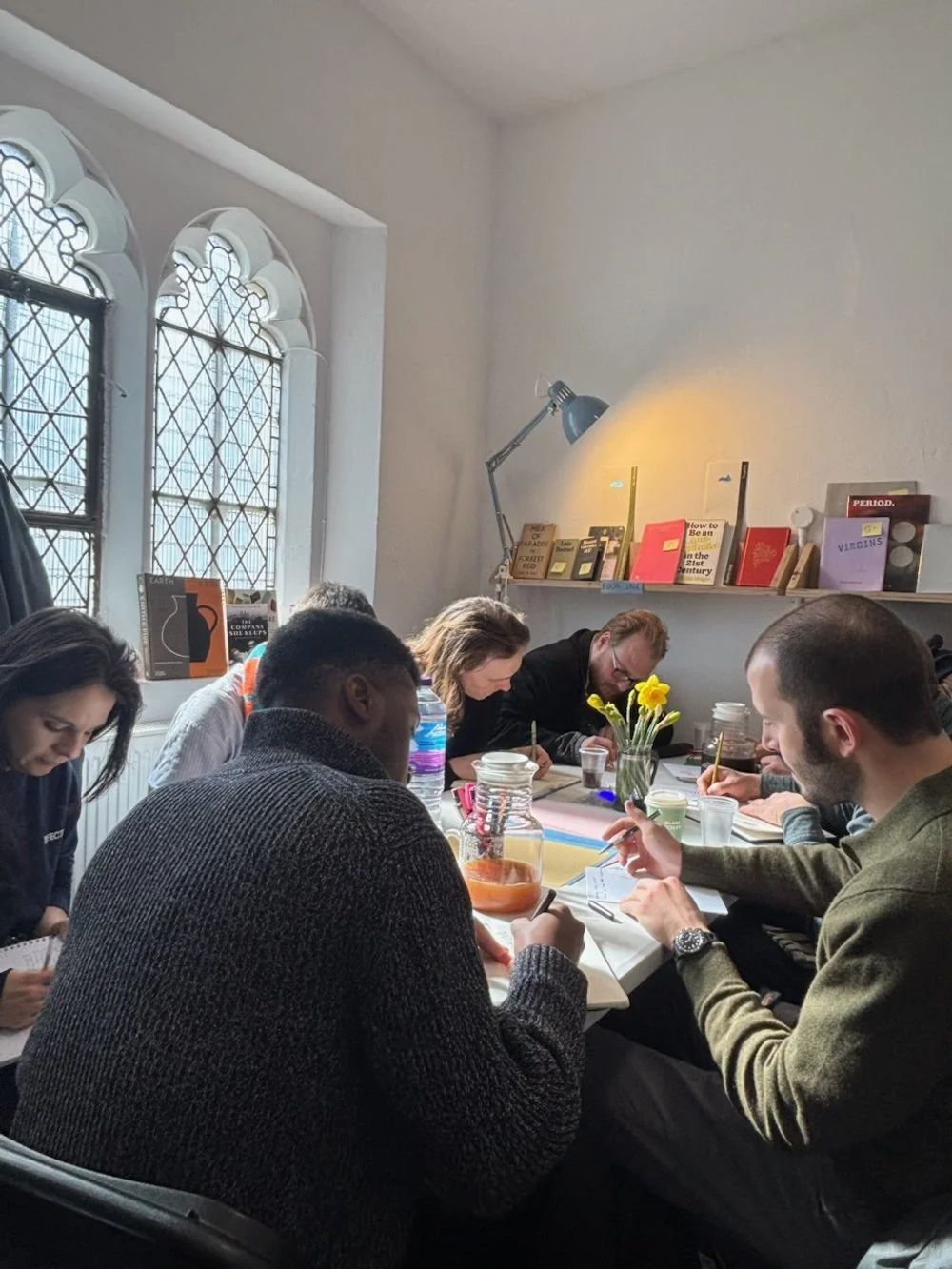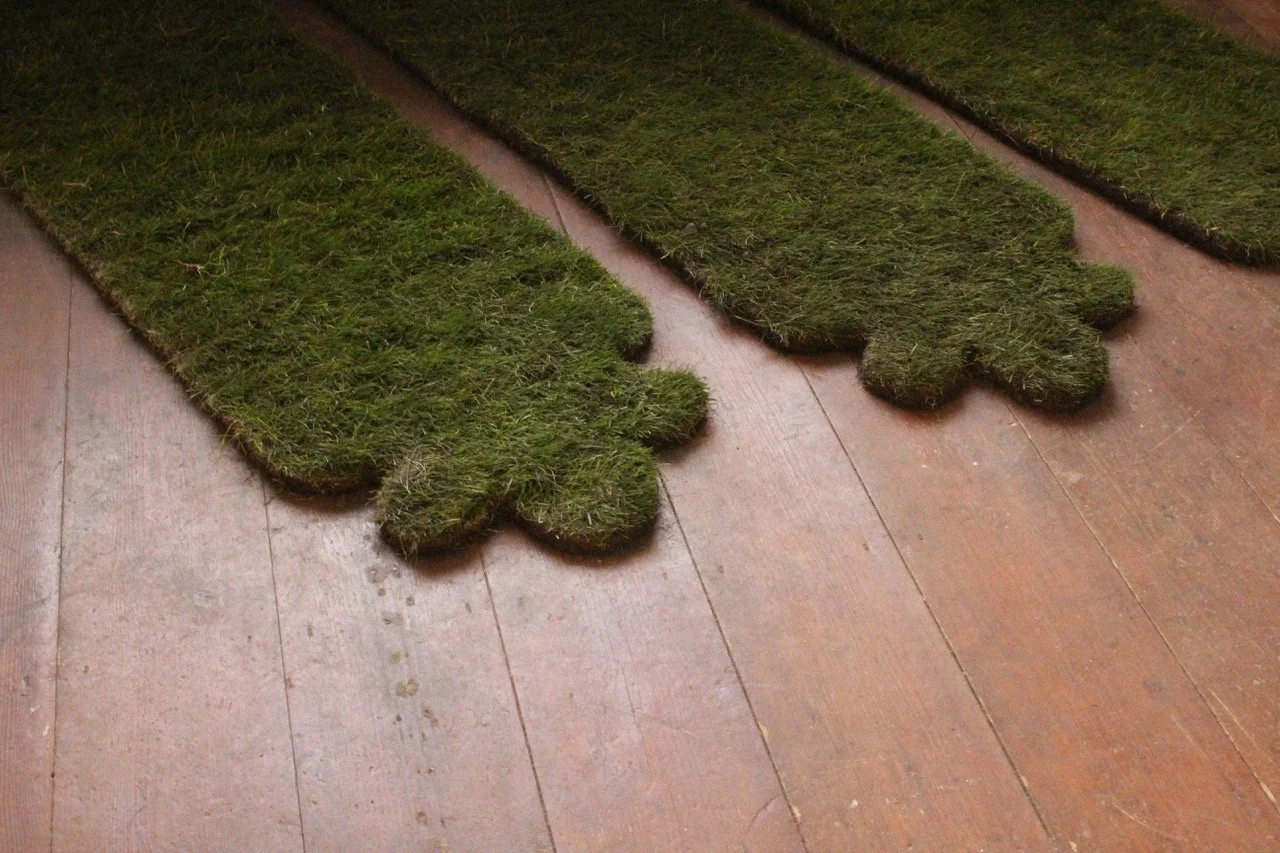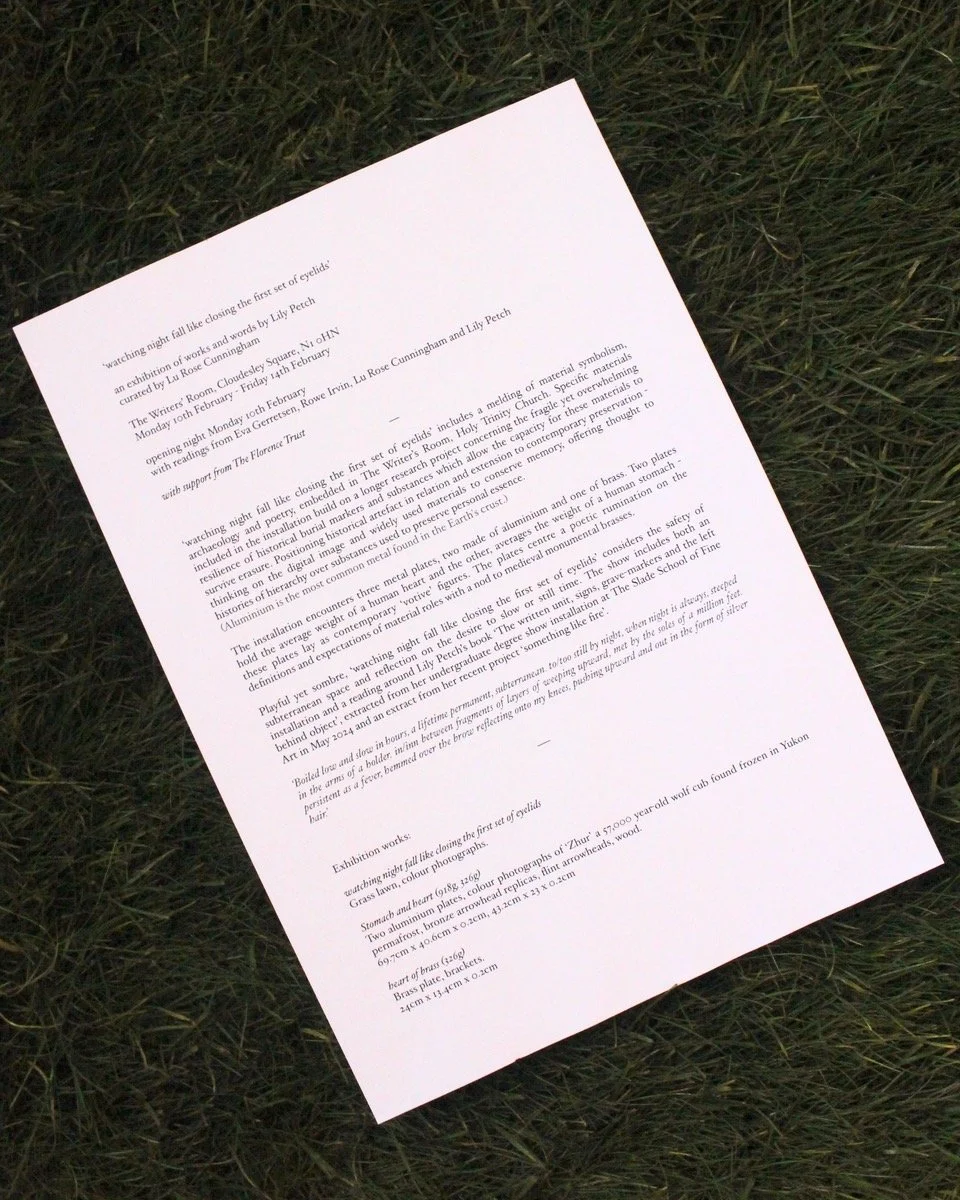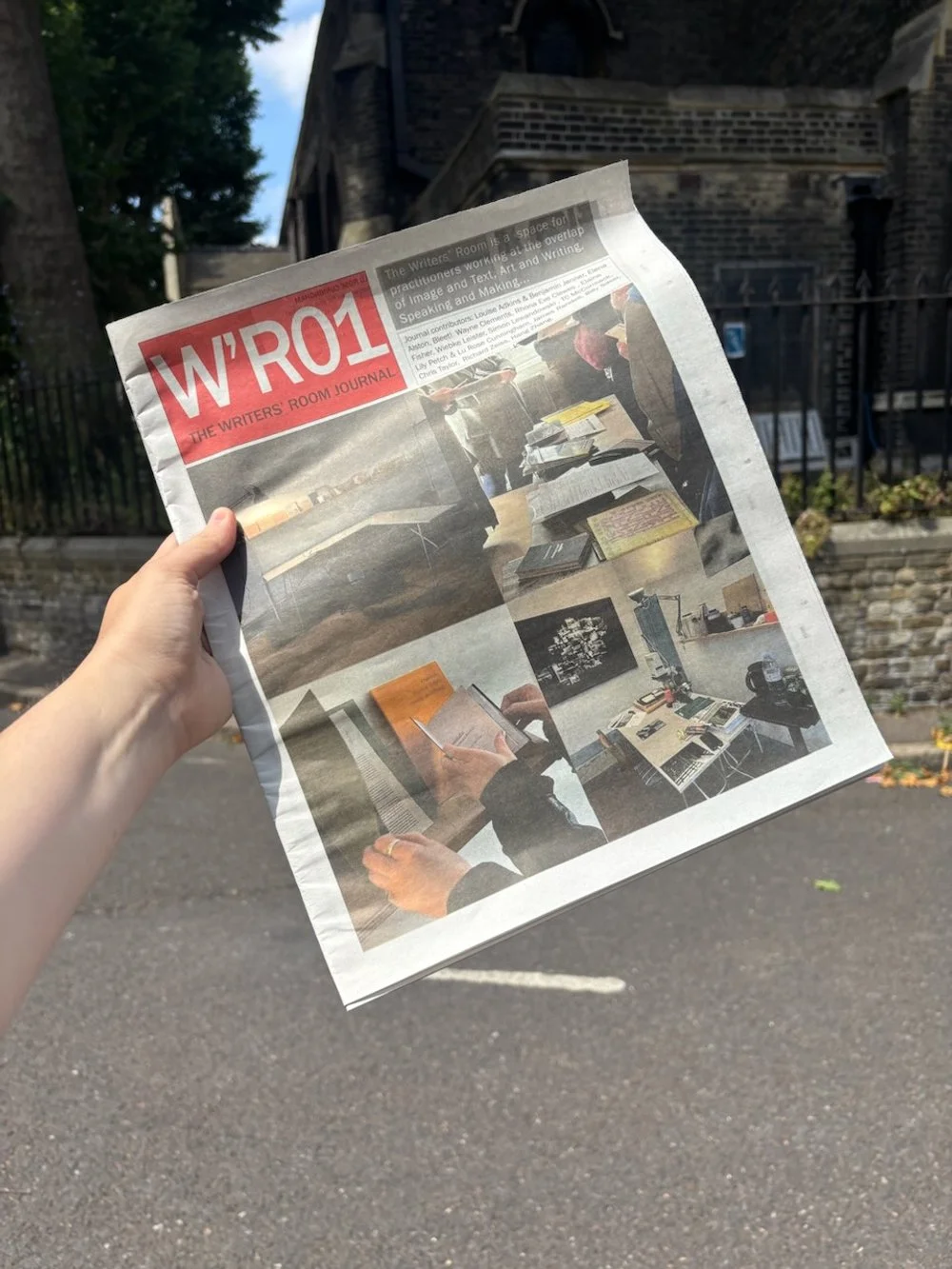Lu Rose Cunningham on The Writers’ Room residency, London, Autumn 2025
Author: Lu Rose Cunningham
Around the time of joining the Curatorial Ethics Network, I reflected deeply on what it means to be a cultural steward for the residency space I run in London, The Writers’ Room, at Holy Trinity Church, Islington. As the space has been in use for 18 months so far, with the programme running on the current site until autumn 2026, I consider the statement released upon opening our doors.
“The Writers’ Room — a newly established branch off existing independent publishing house The Wild Pansy Press (of Leeds and London) — is a site for those working at the intersection of fine art and literature — be that of art writing, memoir, auto-fiction, science fiction,fan-fiction, zine culture, sound art, broadcasting or the spoken word. The space is a working studio,but can be reimagined as a site for publication launches, performances, screenings, or symposia, with scope for intimate or public-facing engagements, with intent to foster connectivity across demographics and practices.” It is, I hope, a place to create something new, imaginative and transforming through the power of language, repositioning reading and writing as a situated embodied engagement.
Fig.1 The Writers’ Room in its earliest form, April 2025
Managing a public-facing programme and new practitioners each month has stretched me, and it has been challenging at times. There are constant administrative and logistical tasks to carry out, whilst ensuring access needs are met both physically and through communications internally and with audiences; studio visits to manage at the space and crits with other practitioners and curators coming to meet residents; mentoring between myself and residents; and workshops, screenings, writing/reading groups and performances to facilitate, events that encompass dynamic interdisciplinary practices.
A few years ago whilst living in Glasgow, I led a self-published project titled Turnings: Writing on Residency, opening up conversations with existing residency programmes across the UK, namely Hospitalfield and COVE PARK in Scotland, and Wysing Arts Centre in Cambridge. Through it, arose many enlightening discussions around the trials of running residency programmes, as well as the many positive impacts. We discussed why artists elect to leave familiar environs; what does it mean to inhabit a place, its geographies, movements, existing community, and what is the cost of doing so? These were times of insight; of uncertainty. I think of Emily Ogden's book On Not Knowing (Peninsular Press, 2022) — one I return to often — noting how she writes of the 'process of not knowing which might engender a relational, aberrant and ecological re-formation of art, classroom and life.’ The term ‘residency’ as a reckoning with afforded time and space, and what may come of that. The act of travel to somewhere new to practice unfolding as a shift both in mind and body; residency attached to a particular place propels immersion from the moment of leaving one's home. Artists feel the change tangibly, residency a confrontation. There is a shape-shifting process of writing that is felt in residencies also, an inherent luxury felt in having such time to use as one wants — though it should be said many residents balance their time on site with work commitments, part-time residences occurring — but also an intense process of giving permission to oneself to make, or not make anything at all, to simply ‘be.’ I came to acknowledge feelings of exposure, and how the hosting (my role) is at times uncomfortable for its performativity, challenging when overseeing many moving parts, and a test, when one has to stop performing and lower guards, because residents are made vulnerable by the experience and the host needs to recognise and support in a raw and genuine way.
Yet we also recognised the excitement that arises around changing constellations of people and conversations, the liveness. And so here I speak of The Writers’ Room with joy and enthusiasm too — it is, at heart, a room full of texts and readers/listeners/thinkers. A bookworm myself, it is special to facilitate such a space. And whilst small in scale, it is forever evolving and shape-shifting, at the whims of the resident in at any given moment; the collaborators invited in to work on projects with people; the audiences who gather to write, discuss or absorb new knowledge and ideas.
Increasingly we’re branching out offsite too — of late The Writers’ Room has partnered with neighbouring gallery CUBITT, for a series of readings and panel discussions in a larger venue to accommodate for our growing engagement with people across the arts and literary community in North London, as well as its Community Press, with whom we exhibited at our first London publishing fair this summer, celebrating self-publishing and community organising with other inspiring writers and book-makers. What came of it was more appreciation for Islington’s histories of radical and self-organised print culture, The Writers’ Room embedding into its local heritage.
From its opening in April 2025 — an afternoon of convening, sharing and imagining — the project has, and continues to, grow as an emerging site of literary and art, for making/thinking/ collaborating, for people within and beyond London. Held within the annex of a church, Holy Trinity in Islington, and supported by arts charity The Florence Trust, myself and my colleague Simon Lewandowski have engaged with over 18 residencies, many offering time and space to not just one practitioner but duos and collectives, all spanning an eclectic array of disciplines including filmmaking, scriptwriting, performance art, print-making, score-writing, expanded vocal technique and simply writing, pen to paper. A joy for words and imagery ignited.
Moments spanning this period include informative open studios with visitors coming through to learn and embrace residents’ work, including Lewisham's Chemist Gallery to visit Billy Sassi and his dynamic film-based work. Wiebke Leister's residency was marked with a series of collaborative performances from writers invited to join in, namely Regina During, Nasim Luczaj, and myself, speaking to serpentine symbolisms and acts of translation, following Wiebke's hypnotic performance held at The National Gallery. Alongside the aforementioned, we've hosted national and international partnerships, including moving-image project ‘DISTANCE, PROXIMITY & CONNECTION’, a continued relationship with our first resident TC McCormack of project space EUCA Annex in Walthamstow. This project saw The Writers’ Room working with TC McCormack and French curator Annie Auchere Aguettaz of ImagesPassages (based in Annecy, France), to exhibit varying time-based media works, drawing filmmakers and fans from across the UK and Europe, creating a bright spark of creativity lit in Islington. It was through this collaboration that I found myself writing an essay on the impact of moving-image, speaking to two of my favourite filmmakers, Vir Andres Hera and Ben Rivers. In moments like these, running The Writers’ Room lends itself to the other side of my own practice — writing, responses to/for/after others’ practices, another form of engagement with those in artistic spheres, and a means to posit myself in closer proximity to different disciplines and figures across cultural spaces.
One of my favourite outcomes of the project is my ongoing partnership with writing collective Bleet!, beginning this Spring with a workshop on speculative fiction, co-authorship and the editorial. With writer Eva Gerretsen we explored bibliomancy via Ursula K. Le Guin's essay ‘Loud Cows’ in their book Space Crone (Silver Press, 2023), creating new texts by collaging, collating language, and re-writing pieces individually and then as a group. Utilising written pieces stemming from the workshop, Bleet! then went onto use the space to record and broadcast their show on Montez Press Radio, which they have now done with relation to us a few times, continuing the reach of the residency and aural/oral experience of texts through an online/on air presence. Connecting with Montez Press has been a pleasurable experience too, being another independent publisher specialising in experimental work by feminist and queer artists, thinkers, and writers. Founded in 2012 and based in New York, their mission is to challenge the traditional publishing system,supporting and empowering marginalised creators. Since Bleet!’s residency, I have invited Bleet! back again to celebrate their latest publication, Blee(eeeeeeeeeeeeeeeeee)t! (Bleet! zine, 2025).
First launched at the Institute of Contemporary Art’s GLUE zine fair in September, the planned night of readings at The Writers’ Room acts to continue the dialogues printed in the publication,with several contributors having joined Bleet!’s workshop previously at our space. For me, curating events and establishing a relationship of longevity with Bleet! has been invaluable and aligns with how I wish to oversee The Writers’ Room, with attentiveness and curiosity in how artists use text, through diverging textual forms and programming performative media. I am reminded just how much residents and their intentions nourish our space, as a site of polyphony of voices, thoughts and words. I asked Bleet! ahead of their next event to reflect on their time within The Writers’ Room:
“Not even a year into our little collective, when it was still very much in its infancy, we were very warmly invited into The Writers’ Room by Lu. At that stage, we were just finding our rhythm; printing zines and putting on sprawling performance art events / live music gigs / poetry readings / pub nights / some kind of mix of all above that we call ‘Lug Holes’. This was fun and chaotic, and thrust us into a truly valuable logistical understanding of how to facilitate in the arts. Although we loved the intensity, the practicality of running a growing collective meant prioritising spreadsheet and emails over nurturing the creative core of Bleet!.”
Regarding The Writers’ Room, warmth is the first thing that comes to mind. Whether we’ve had the space for an afternoon to host a workshop, or a month for a hub to grow our thoughts and practices, the room has felt like a little home-away-from home, and the only physical space Bleet! has ever had. The room is a special thing that has been built by truly special people, so thank you Lu for seeing something in our madness and understanding how to iron it into something meaningful. From intuiting our needs in the form of extra chairs or drinks or shelves to lending us our wonderful words in one of our long zines, your collaboration has truly expanded our imagination and Bleet! too.’
Fig.2 Bleet!’s first writing workshop at The Writers’Room, March 2025
Following this idea of continued relations with previous residents, I think about James Randell, printmaker and performance artist who resided with us earlier this year. By curating works made during his time at The Writers’ Room in a group exhibition, he invited me to run an ekphrasis writing workshop with him, opening up this visual-textual linkage with members of the public, and by extension making more people aware of the project. Welcoming opportunities for collaborative working methodologies and encouraging writing and listening between strangers, who in this case left invigorated and with new texts to share, is something truly invigorating and it’s a key stimulant for me carrying out my role.Speaking to James regarding his periods working with The Writers’ Room, James shared that:
“I had run artist-run projects in my twenties, but post-COVID and with the natural turnover of careers and relationships, I found myself somewhat more isolated as an artist, in search of those conversations and experiences that are specific to makers — the kind of lively, amorphous, and speculative chats that I need to keep going with an eclectic practice across media. It’s important to have people you respect express enthusiasm for what you do, at least every now and then.I was delighted to get access to The Writers’ Room residency. I have always written a bit and used text in the context of my collage and performance work, but the useful discomfort of attempts, alone in a small room, to seriously stretch out these muscles has helped open a channel to experiment more confidently with writing as part of my practice. The attitude of both Simon and Lu as artists and communicators, in their own ways, seems to be to embrace the open-ended and the vulnerability of leaving space for an audience. At times I’m a little agoraphobic... Having access to blank space and a network of artists and audience members to participate in the experimental, growing phases of a project (through open studios, workshops, etc.) was brilliant as it affirmed the avenues of inquiry worth following much more nakedly. My residency has resulted inpieces of text, workshops and a group show at The Florence Trust this year that developed from my research and will hopefully have further iterations. I am continuing the research that I started at The Writer’s Room and keep finding richer and more murky depths to plumb.”
James framed it as ‘avenues of inquiry’. I returned again to the impetus for running the Writers’ Room — of working between image and text — and recalled a project earlier this year with artist Lily Petch, for the first time hosting a site-specific exhibition in the space, titled ‘watching night fall like closing the first set of eyelids’. Only a week long, the central work in the show was a series of grass strips cut to size and shape of the room’s windows, placed at such an angle on the ground as to embody shadows from light passing. Over the course of a week, Lily spent time refining a body of written work and the presentation of metal etched plates, whilst the grass began to dry out and adjust to the conditions of the room and changing light inside. Other works included etchings and Lily’s self-published book, ‘The written unit, signs, grave markers and the left behind object’.
Within this time frame, Lily was drawn to the sense of architecture and time, the feeling of day stretching longer when working intensely in the space and coming close to the texture and narrative of objects and surfaces worked with. Her exhibition — of writing and sculpture — was the first intervention of such nature in the space, highlighting the scope for the room to be both aworking studio and for exhibiting, outside the conventional white cube gallery format, a space replete with its own existing imagery. The show spoke to a melding of material symbolism, archaeology, poetry, a re-surfacing of rites and memory, all embedded in the Writers’ Room home of a church. Meeting with Lily more recently for a catchup — Lily and I have become friends since this exhibition — we reflected back on this period. Lily recollected:
“I originally met Lu over Instagram due to our mutual interest in artists writing, poetry, and artwork around archaeology, flight and light, and then in person during my BA degree show in 2024. We spoke at length about our practices and current views on artist’s writing and research,before Lu generously proposed to host an event in support of my practice. As my practice often involves embedding works into the architecture of specific locations, The Writer’s Room offered an alternative space which allowed me to continue this ethos — particularly fitting in a church room, following a previous body of research into burial rites and excavations.The approachability and atmosphere of the space — distinct from a usual white cube setup — enabled the research, writing, and sculptural, votive-like elements in the show to feel deeply comfortable and held. watching night fall like closing the first set of eyelids featured four readings on the opening night by Eva Gerretsen, Rowe Irvin, Lu and myself; this brought an unparalleled warmth to the space which reflected onto the work itself. This was made possible through Lu’s conscientious curation, her words of encouragement, and her practical support, all of which enabled the show to run smoothly and represent my work authentically.”
Fig.3 and fig.4 Lily Petch’s exhibition, February 2025; a direct response to the architecture and history of the site, with grass shadows, cut exact to the room’s windows, which audiences could touch.
Moving forwards, the project’s future plans involve retaining and nurturing our current space, and working on funding applications. At present, we kindly receive funding and the space from The Florence Trust, and occasional ticketed events and workshops, yet to continue and expand the work and outreach programme we see the benefits of more funding to stretch the materials budget for each resident; to pay for equipment for printing and devices for documenting events better; for inviting in paid speakers and performers from outside of London; and to cover the time we increasingly offer to the more ambitious residencies. I am excited to announce an already programmed lineup until August 2026, with new residents planned including an amazing trans performance artist and writer Donna Marcus, and extending our international reach to Esmé Hogeveen, a writer and events-organiser from Canada.
Additionally, we hope to take The Writers’ Room to Leeds for a temporary off-site project next Spring, returning to where The Wild Pansy Press began at University of Leeds’ School of Fine Art. We hope to create an active archive of past projects and an intimate reading space, presenting the projects to date and encouraging wider conversations, as well as elevating projects of the residents we’ve had from Yorkshire or those who work between London and Northern cities, of which we have welcomed a few, and drawing them into dialogues with practitioners in similar fields there. Lastly, we plan to continue the newspaper anthology of writing from contributors to date, with the existing newspaper documenting each resident from last April to March 2025, with imagery, creative writing and workshop plans for readers to enjoy and learn from. I see this as another curatorial approach, curation not only unfurling via in-person encounters but through publications; printed matter as a tangible, potentially wider-reaching mode of sharing ideas and work, with its readership reaching those who can’t make it to the space or wish to recall what we have hosted!
And on a final note, beyond the residential and public-facing aspects of the project, are the friendships and working relationships forged internally. I'm thankful for Simon for co-running the space with me and introducing me initially to a world of printed matter; to Chris Taylor for his support from afar at University of Leeds; for Steve Allbutt and Yuka Namekawa of The Florence Trust for their continued support with The Writers' Room; and for the encouraging artistic community flourishing constantly at Holy Trinity.
@lurosecunningham
@wpp_writersoom
@florencetrust
@bleet_zine
@montezpressradio
https://radio.montezpress.com/#/archive
https://thenewbridgeproject.com/product/turnings-writing-on-residency/
All views expressed in this article are the author’s own.
Images provided by Lu Rose Cunningham.
Fig.5 The Writers’ Room first newspaper contributors’ anthology, released summer 2025




